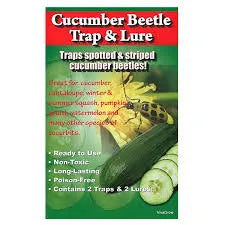Cucumber Beetle Traps 2 pk
Are you frustrated by your crop being eating by cucumber beetles?
Cucumber Beetles are a major problem wherever cucumber, watermelon, pumpkin, cantaloupe, squash and other cucurbits are grown. Beetles can kill or severely stunt seedlings and on older plants damage stems and fruits. The beetle is well known for transmitting bacterial wilt, and some viruses. Gummy stem blight is also associated with beetle damage. Larvae feed on roots, reducing yield.
The trap contains a strong adhesive to hold beetles that are attracted to the multi-pheromone lure. Place in garden when seedlings start to emerge or beetles appear and start feeding on flowers and foliage. This trap is simple to use, placing the lure on yellow sticky trap and hanging near your garden.
Features:
- Lure will attract various types of cucumber beetles including Striped cucumber (Acalymma vittatum), Western striped (Acalymma trivittatum), Spotted cucumber (Diabrotica undecimpunctata howardi) and Western spotted cucumber beetle (Diabrotica undecimpunctata undecimpunctata)
- Use one trap with lure per 185 m2 (2,000 sq2) for monitoring or one trap/lure per 37m2 (400 sq2) for mass trapping.
- The lure lasts for 3-4 weeks depending on temperature and replace trap when full of beetles of dirty.
Gardeners Helpers for Managing Cucumber Beetles:
- Crop Rotation: Crop rotation is an effective way to control cucumber beetles. Move your cucumbers to a new location each year to avoid buildup of pest populations in the area
- Companion Planting: Planting herbs such as tansy, catnip, and radishes near cucumbers can help repel cucumber beetles. Planting nasturtiums near cucumbers can also deter aphids from the cucumber plants.
- Row Covers: Covering your cucumber plants with a row cover can prevent cucumber beetles from landing on and eating the leaves. Be sure to remove the covers once the plants begin to flower to allow for pollination.
- Handpicking: You can also handpick cucumber beetles from your plants and drop them into a bucket of soapy water. This can be a time-consuming process, but it is effective for small gardens.

